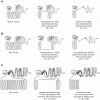Animal models of gastrointestinal and liver diseases. Animal models of infant short bowel syndrome: translational relevance and challenges
- PMID: 25342047
- PMCID: PMC4269678
- DOI: 10.1152/ajpgi.00088.2014
Animal models of gastrointestinal and liver diseases. Animal models of infant short bowel syndrome: translational relevance and challenges
Abstract
Intestinal failure (IF), due to short bowel syndrome (SBS), results from surgical resection of a major portion of the intestine, leading to reduced nutrient absorption and need for parenteral nutrition (PN). The incidence is highest in infants and relates to preterm birth, necrotizing enterocolitis, atresia, gastroschisis, volvulus, and aganglionosis. Patient outcomes have improved, but there is a need to develop new therapies for SBS and to understand intestinal adaptation after different diseases, resection types, and nutritional and pharmacological interventions. Animal studies are needed to carefully evaluate the cellular mechanisms, safety, and translational relevance of new procedures. Distal intestinal resection, without a functioning colon, results in the most severe complications and adaptation may depend on the age at resection (preterm, term, young, adult). Clinically relevant therapies have recently been suggested from studies in preterm and term PN-dependent SBS piglets, with or without a functional colon. Studies in rats and mice have specifically addressed the fundamental physiological processes underlying adaptation at the cellular level, such as regulation of mucosal proliferation, apoptosis, transport, and digestive enzyme expression, and easily allow exogenous or genetic manipulation of growth factors and their receptors (e.g., glucagon-like peptide 2, growth hormone, insulin-like growth factor 1, epidermal growth factor, keratinocyte growth factor). The greater size of rats, and especially young pigs, is an advantage for testing surgical procedures and nutritional interventions (e.g., PN, milk diets, long-/short-chain lipids, pre- and probiotics). Conversely, newborn pigs (preterm or term) and weanling rats provide better insights into the developmental aspects of treatment for SBS in infants owing to their immature intestines. The review shows that a balance among practical, economical, experimental, and ethical constraints will determine the choice of SBS model for each clinical or basic research question.
Keywords: glucagon-like peptide 2; intestine; mouse; newborn; parenteral and enteral nutrition; pig; rat; resection.
Copyright © 2014 the American Physiological Society.
Figures




References
-
- Almond SL, Haveliwala Z, Khalil B, Morabito A. Autologous intestinal reconstructive surgery to reduce bowel dilatation improves intestinal adaptation in children with short bowel syndrome. J Pediatr Gastroenterol Nutr 56: 631–634, 2013. - PubMed
-
- Altmann GG. Influence of bile and pancreatic secretions on the size of the intestinal villi in the rat. Am J Anat 132: 167–177, 1971. - PubMed
-
- Amin H, Holst JJ, Hartmann B, Wallace L, Wright J, Sigalet DL. Functional ontogeny of the proglucagon-derived peptide axis in the premature human neonate. Pediatrics 121: e180–e186, 2008. - PubMed
-
- Andorsky DJ, Lund DP, Lillehei CW, Jaksic T, DiCanzio J, Richardson DS, Collier SB, Lo C, Duggan C. Nutritional and other postoperative management of neonates with short bowel syndrome correlates with clinical outcomes. J Pediatr 139: 27–33, 2001. - PubMed
-
- Aunsholt L, Jeppesen PB, Lund P, Sangild PT, Ifaoui IB, Qvist N, Husby S. Bovine colostrum to children with short bowel syndrome: a randomized, double-blind, crossover pilot study. JPEN J Parenter Enteral Nutr 38: 99–106, 2014. - PubMed
Publication types
MeSH terms
Grants and funding
LinkOut - more resources
Full Text Sources
Other Literature Sources
Miscellaneous

